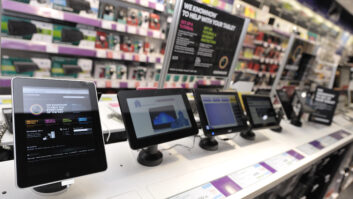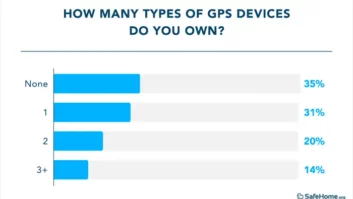NEW YORK –
Japanese CE makers had a tough fiscal
second quarter, with due to still struggling North
America and European markets, and exchange rates
for the Japanese yen.
Japanese-based manufacturers Panasonic and
Sony took the biggest hits in their fiscal Q3. For their
Korean counterparts it was a mixed bag, with Samsung
posting a profit but LG Electronics reporting a
loss for the same period.
Panasonic
blamed its net loss and lower sales
in its fiscal second quarter, ended Sept. 30 on economic
factors, the higher value of the yen and lower
prices for CE products.
Consolidated group sales for the second quarter
decreased by 6 percent to 2,075.7 billion yen, from
2,206.8 billion yen, compared with the same period
a year ago. Net loss was 105.8 billion yen in the
quarter, compared with a profit of 31 billion yen a
year ago. And its operating profit decreased to 42.0
billion yen, from 85.2 billion yen a year ago.
Panasonic is also projecting a net loss for fiscal
year 2012 ending March 31, 2012, of 420 billion yen,
compared with the previous forecast of an income of
30 billion yen, with lower sales of 8,300 billion yen,
down from the previous 8,700 billion yen.
While there have been plenty of rumors about
changes in its flat-panel TV business, no details on
the restructuring of it, or the semiconductor business,
were provided, which Panasonic expects to
cost 404 billion yen.
Sony
reported a net loss and lower sales in its
fiscal second quarter, projected a $1.2 billion loss
for its fiscal year, and provided details on the realignment
of its TV operations. (See p. 4.) Sony blamed
its problems on three areas: foreign exchange rates
for the yen; lower LCD TV sales and profitability;
and, for the entire fiscal year, the impact of the floods
in Thailand.
Sales and operating revenue for the quarter was
1,575 billion yen, or $20.5 billion, down 9.1 percent
year on year. The net loss was 27 billion yen, or $350
billion, compared with net income of 31.1 billion yen
year on year. Its operating loss of 1.6 billion yen, or
$21 million, compared with operating profit of 68.7
billion yen last year was
due to a decrease in gross
profits due to lower sales in
LCD TVs.
Sony is now projecting
a net loss of 90 billion yen
for the fiscal year ending
March 31, 2012, as compared
with a July forecast
of a 60 billion profit and
an actual loss of 259.6 billion
yen in the prior fiscal
year. Sales and operating
revenue is now forecast
at 6,500 billion yen, down
from the July forecast of
7,200 billion yen and 9.5 percent down from the
prior fiscal year’s results.
Toshiba’s
digital products segment during the fiscal
second quarter, ended Sept. 30, which includes CE
products, had higher operating income. Sales in this
segment fell 5 percent to 450.9 billion yen, with operating
income at 4.5 billion yen, rising 0.5 billion yen.
Toshiba said that while the segment recorded lower
sales in Europe and the U.S. and was impacted by
the yen’s appreciation, operating income increased
due to “proactive cost reductions, lower parts and
materials costs.”
Sharp Electronics
reported lower net sales, but
higher net income for its fiscal second quarter, and it
cut its fiscal year forecast. Net sales were 674.2 billion
yen, down 11.6 percent compared with the prior
year’s fiscal second quarter. Net income was 9.4 billion
yen, 2.5 times that of the same period last year.
In its audio-visual and communications unit, sales
were down 15 percent in the fiscal first half to 580.7
billion yen, compared with last year due mainly to
sales of LCD TVs and
lower pricing, despite an
increase in unit sales.
Sharp now forecasts
net sales to be 2,800
billion yen, down from
the previous forecast of
3,050 billion yen. Operating
income is now
forecast at 85 billion
yen, from the previous
forecast of 97 billion
yen. Net income should
be the same as previously
forecast, at 6 billion
yen.
Samsung Electronics
reported lower net income
but slightly higher revenue for its fiscal third quarter,
ended Sept. 30. Revenues were 41.27 trillion Korean
won on a consolidated basis, a 3 percent increase
year on year and consolidated net income of 3.44
trillion won, represented a 23 percent decrease year
on year.
Samsung’s mobile communications business saw
revenues rise 39 percent year on year to 14.42 trillion
won. Handset shipments rose more than 20
percent quarter on quarter, driven by growth in the
smartphone segment where sales were up more
than 40 percent quarter on quarter and 300 percent
year on year. Samsung continued the global rollout
of its flagship Galaxy SII, which has now sold more
than 10 million units in the five months since its introduction.
Samsung’s shipments of flat-panel TVs outstripped
market growth of more than 10 percent quarter on
quarter, which was led by demand in emerging markets.
Profitability also improved quarter on quarter as
LED TV sales passed 50 percent of all Samsung LCD
TVs sold for the quarter, reflecting the growing acceptance
of the new technology, the company said.
LG Electronics reported a net loss for its fiscal
third quarter, ended Sept. 30, due in large part to
heavy equity declines in its flat-panel business operations.
However, the company said it expects to see modest
sales growth in the next few months, fueled by
sales of higher margined smartphones and 3DTVs.
According to the third-quarter financial report, significant
improvement was made in the company’s handset
operations, which helped reduce LG’s operating
loss over the past year.
LG reported a net loss of $366 million for the three
months, ended Sept. 30, after booking a 257.9 billion
won equity loss in the quarter from the LG Display
unit.
Overall sales declined 4 percent to 12.9 trillion
won during the quarter, from 13.43 trillion won.
LG reported selling 21.1 million handsets, down
from 24.8 million units in the second quarter. The
operating loss margin grew to 5.2 percent, from 1.7
percent in the second quarter. The TV business unit
showed a 1.9 percent operating profit margin, up
from 1.7 percent in the second quarter.













